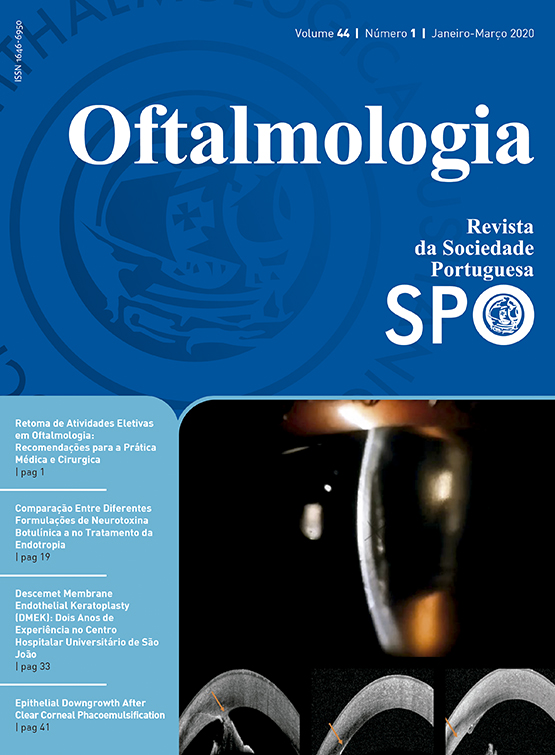Epithelial downgrowth after clear corneal phacoemulsification
DOI:
https://doi.org/10.48560/rspo.19335Abstract
Abstract
Purpose
The purpose of this article is to report a case of epithelial downgrowth after clear corneal phacoemulsification.
Materials and methods
The authors report the case of a 79-year-old man submitted to left eye phacoemulsification, through a clear corneal, 2.75mm incision with intra-ocular lens (IOL) implantation. Surgery was uneventful except for intraoperative floppy iris syndrome (IFIS) which caused minimal iris incarceration. At postoperative days 1 and 7 no abnormalities were detected for the exception of minimal iris incarceration. At 1-month appointment, a diffuse sheet of epithelium was observed with respect to the main wound and the incarcerated iris. The patient was asymptomatic, best corrected visual acuity (BCVA) was 7/10 and intra-ocular pressure (IOP) was 16mmHg. No intra-ocular inflammation was detected. A clinical diagnosis of epithelial downgrowth was assumed and subsequently supported by suggestive anterior segment optic coherency tomography (OCT), specular microscopy and corneal topography.
Results
At 5-month follow-up the patient remained asymptomatic, with no evidence of epithelial downgrowth spreading, besides iris incarceration. BCVA and IOP continue stable 7/10 and 16mmHg, respectively, and the eye remained with no inflammation.
Discussion
Predisposing situations for the invasion of epithelium into the anterior chamber include numerous intraocular surgeries, incomplete or delayed wound healing, iris incarceration and implantation of epithelial cells with instruments. The precise understanding of the pathogenesis is still unknown. The outcomes of treatment are variable and generally unsatisfactory with no clear treatment guidelines. In this case the main risk factor identified was IFIS with iris incarceration
Conclusions
Although the prognosis of this disease is usually poor, at 5-months follow-up the patient remained asymptomatic with no evidence of epithelial spreading.
Key words: epithelial invasion, phacoemulsification, floppy iris syndrome
Downloads
Downloads
Published
How to Cite
Issue
Section
License
Do not forget to download the Authorship responsibility statement/Authorization for Publication and Conflict of Interest.
The article can only be submitted with these two documents.
To obtain the Authorship responsibility statement/Authorization for Publication file, click here.
To obtain the Conflict of Interest file (ICMJE template), click here







